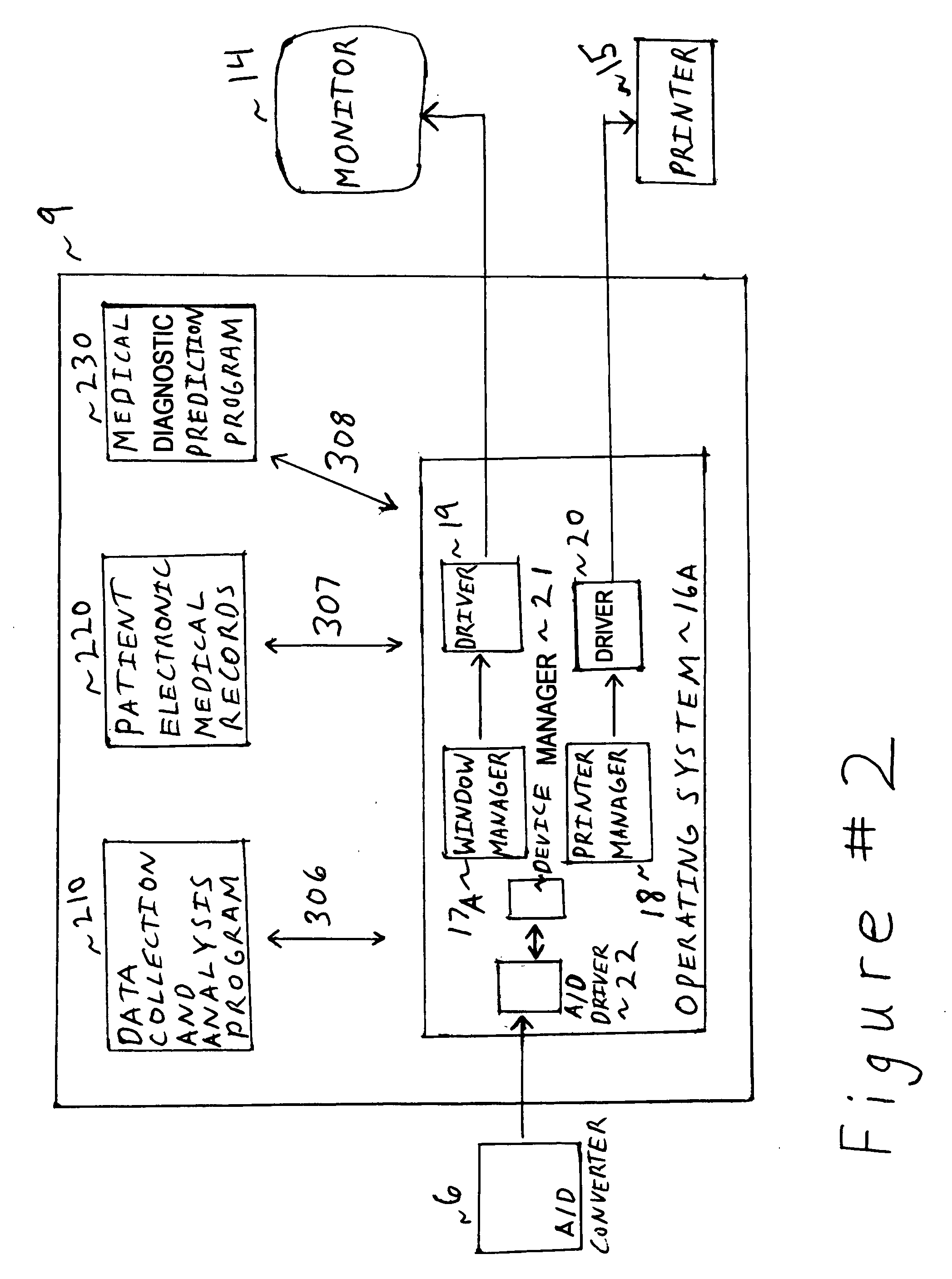[0010] It has been proven that organs in the
human body emit characteristic physiologic signals when they are functioning in the absence of
pathology. It is an object of the present invention to provide an improved
system for accurately assessing organ (particularly
lung) function and thereby facilitating the diagnosis of certain diseases based upon
digital recording,
processing and analysis of these physiologic sounds.
[0011] One of the main obstacles to widespread acceptance of electronic stethoscopes is that these devices are too cumbersome, and also, too complicated for health care professionals to operate in a professional setting. Thus, it is a further object of this invention to provide a compact, customizable device. But most important, the device will be an improvement over analogous art by providing a simple interface which allows medical professionals with limited technical background to easily manipulate vital parameters such as block length, overlap, sampling rate, low / high pass filtering, adjusting the Fast Frouier Transformation (FFT) and RMS analysis to cover any component of the
frequency spectrum, and applying data windows without the need for
computer programming knowledge.
[0012] Another object of this invention is to boost the accuracy of recording physiological sounds by providing the physician with an efficient method of eliminating
background noise (which is either present in the ambient environment and / or emitted by other
body organs in the vicinity of the
transducer) from the desired
signal in real time. Accomplishing this task will not only lead to greater accuracy in the measurement of physiologic sounds, but it will also allow the device to operate with a greater degree of autonomy when compared to analogous art.
[0015] The system also includes a
digital signal processor for conditioning the
signal (filtering, gating, limiting, or excluding
background noise). In the preferred embodiment of the invention, analogue circuitry or a
digital signal processor employing Super Harvard Architecture (SHARC) can be added for additional filtering, expansion, compression or conversion of the processed signal back to
sound energy thereby enabling the operator to hear the altered sound in real time. After processing, the analogue signals generated by the transducers arc converted into
digital data and transferred to a computer
workstation. In order to increase the portability of this device,
digital data may be transmitted to the
workstation over
wireless internet. A further
advantage of utilizing a SHARC processor is that optimal settings for detecting sound from a variety of sources may be stored in memory for instantaneous recall by the operator. These aforementioned settings which are programed into the SHARC processor may enable the claimed invention to acquire properties of sound transmition which are identical to a conventional acoustic
stethoscope. This is important because acoustic stethoscopes remain popular in
clinical settings due to the fact that a tremendous amount of research has already been done with them and the steadfast hestiancy among health-care professionals to abandon their use of these devices.
[0017] Executing on the computer is an application program constructed from a set of modular elements synthesized using a graphical
programming language. The application program collects the data and organizes it into discrete sections (blocks) before moving it though a series of modules. By clicking on any specific module with the mouse, the operator can set the sampling rate,
block size and overlap. Furthermore, the operator may elect to further high /
low pass filter the data digitally or apply a mathematical window analogous to FFT processing in order to minimize
distortion of calculated results.
[0019] As the PSD is calculated for each incoming block, the computer may exclude portions of the PSD that are outside the selected thresholds specified by the operator. This is possible because the program may contain a trigger, which enables the operator to exclude portions of the spectrum, which are not of interest with a simple mouse click. Once the PSD is determined, the program calculates the
root mean square (RMS) value of the signal in the
frequency band(s) chosen by the operator. The computer performs this calculation on each incoming block and displays the data as a
list during the time of operation. This method is method is highly advantageous to the clinician since it takes a very complicated quantity (the PSD of each block that gives information about the power of all frequency components in the block) and converts it into a simple quantity (RMS), while still relaying the necessary information about the signal to the clinician. Secondly, by performing these calculations on each incoming block of the data, the properties of the signal outlined above can be analyzed as they vary over time. The clinician can then use this information about an organ's spectral characteristics to assess its' degree of functionality in a quick, inexpensive, accurate and non-invasive manner. The analysis program illustrated in the present invention can be used either as a stand alone application or in combination with a number of additional program elements which may include patient's electronic medical records. As a result, this system has the potential to dramatically improve efficiency in the healthcare system and clinical outcomes for patients.
 Login to View More
Login to View More  Login to View More
Login to View More 


